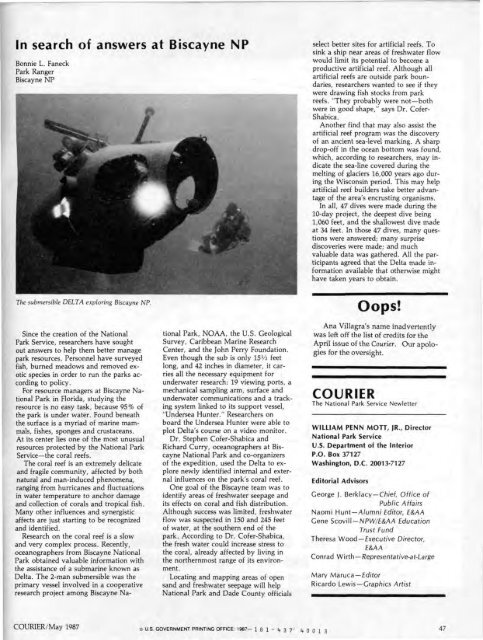Create successful ePaper yourself
Turn your PDF publications into a flip-book with our unique Google optimized e-Paper software.
In search of answers at Biscayne NPBonnie L. Faneck<strong>Park</strong> RangerBiscayne NPThe submersible DELTA exploring Biscayne NP.Since the creation of the <strong>National</strong><strong>Park</strong> <strong>Service</strong>, researchers have soughtout answers to help them better managepark resources. Personnel have surveyedfish, burned meadows and removed exoticspecies in order to run the parks accordingto policy.For resource managers at Biscayne <strong>National</strong><strong>Park</strong> in Florida, studying theresource is no easy task, because 95% ofthe park is under water. Found beneaththe surface is a myriad of marine mammals,fishes, sponges and crustaceans.At its center lies one of the most unusualresources protected by the <strong>National</strong> <strong>Park</strong><strong>Service</strong>—the coral reefs.The coral reef is an extremely delicateand fragile community, affected by bothnatural and man-induced phenomena,ranging from hurricanes and fluctuationsin water temperature to anchor damageand collection of corals and tropical fish.Many other influences and synergisticaffects are just starting to be recognizedand identified.Research on the coral reef is a slowand very complex process. Recently,oceanographers from Biscayne <strong>National</strong><strong>Park</strong> obtained valuable information withthe assistance of a submarine known asDelta. The 2-man submersible was theprimary vessel involved in a cooperativeresearch project among Biscayne <strong>National</strong><strong>Park</strong>, NOAA, the U.S. GeologicalSurvey, Caribbean Marine ResearchCenter, and the John Perry Foundation.Even though the sub is only 15 Vi feetlong, and 42 inches in diameter, it carriesall the necessary equipment forunderwater research: 19 viewing ports, amechanical sampling arm, surface andunderwater communications and a trackingsystem linked to its support vessel,"Undersea Hunter." Researchers onboard the Undersea Hunter were able toplot Delta's course on a video monitor.Dr. Stephen Cofer-Shabica andRichard Curry, oceanographers at Biscayne<strong>National</strong> <strong>Park</strong> and co-organizersof the expedition, used the Delta to explorenewly identified internal and externalinfluences on the park's coral reef.One goal of the Biscayne team was toidentify areas of freshwater seepage andits effects on coral and fish distribution.Although success was limited, freshwaterflow was suspected in 150 and 245 feetof water, at the southern end of thepark. According to Dr. Cofer-Shabica,the fresh water could increase stress tothe coral, already affected by living inthe northernmost range of its environment.Locating and mapping areas of opensand and freshwater seepage will help<strong>National</strong> <strong>Park</strong> and Dade County officialsselect better sites for artificial reefs. Tosink a ship near areas of freshwater flowwould limit its potential to become aproductive artificial reef. Although allartificial reefs are outside park boundaries,researchers wanted to see if theywere drawing fish stocks from parkreefs. "They probably were not—bothwere in good shape," says Dr. Cofer-Shabica.Another find that may also assist theartificial reef program was the discoveryof an ancient sea-level marking. A sharpdrop-off in the ocean bottom was found,which, according to researchers, may indicatethe sea-line covered during themelting of glaciers 16,000 years ago duringthe Wisconsin period. This may helpartificial reef builders take better advantageof the area's encrusting organisms.In all, 47 dives were made during the10-day project, the deepest dive being1,060 feet, and the shallowest dive madeat 34 feet. In those 47 dives, many questionswere answered; many surprisediscoveries were made; and muchvaluable data was gathered. All the participantsagreed that the Delta made informationavailable that otherwise mighthave taken years to obtain.Oops!Ana Villagra's name inadvertentlywas left off the list of credits for theApril issue of the Courier. Our apologiesfor the oversight.<strong>COURIER</strong>The <strong>National</strong> <strong>Park</strong> <strong>Service</strong> NewletterWILLIAM PENN MOTT, JR., Director<strong>National</strong> <strong>Park</strong> <strong>Service</strong>U.S. Department of the InteriorP.O. Box 37127Washington, D.C. 20013-7127Editorial AdvisorsGeorge J. Berklacy — Chief, Office ofPublic AffairsNaomi Hunt—Alumni Editor, E&AAGene Scovill-NPW/£&AA EducationTrust FundTheresa Wood — Executive Director,E&AAConrad Wirth — Representative-at-LargeMary Maruca — EditorRicardo Lewis — GraphicsArtist<strong>COURIER</strong>/May 1987 i, U.S. GOVERNMENT PRINTING OFFICE 1987— 1 8 1 - 4 3 7 4 0 0 1 3 47




